May 6 - May 8, 2014
We checked out of Yap on the morning of our departure. The Yap officials would not permit us to check out late the afternoon before and leave at the crack of dawn, as we had wanted to. So we had to wait until their office opened at 8am to check out. But it was done quickly and painlessly and without cost. We made one last stop at the grocery store--hoping that tomatoes would have magically appeared on the shelves. But alas, we had to make our passage tomato-free.
As seems to have been the pattern during our whole trip across Micronesia, we left port on another long passage with the promise of wind that never materialized.
And also true to form, Dave didn't want to drift along in the light winds, so we motored a lot of the way to Palau.
The entire trip was pretty uneventful. We spent most of the second day with passing squalls and doing the zero-to-25-to-zero squall "two step". But about midnight that day, the final squall passed and our last 12 hours was pretty good.
The whole passage was 260 miles, from the anchorage in Yap to the commercial wharf in Palau. It took us 53 hours, and we motored 31 hours of that.
Our check-in in Palau was pretty hassle-free. We tied up to the commercial wharf at 1pm, and by about 3pm, we were completely done. The whole thing cost $150 U.S. And as Americans, we have a year in Palau before we need to worry about a visa extension. (Non-Americans get 1 month, extendable to 3 at a cost of about $100 per month).
By 3:30pm we were on the Guest Mooring off Sam's Tours, and by 5pm we were enjoying a nice cold draft Red Rooster beer (great German beer brewed in Palau) at the bar at Sams. Hot showers, nice dinghy dock, etc.
-----
At 05/08/2014 9:17 PM (utc) our position was 07°20.32'N 134°27.17'E
Join Dave and Sherry on their cruise around the world on their St. Francis 44 catamaran.
(Finally have left the Philippines and are currently cruising Indonesia)
Sunday, May 18, 2014
A Week in Yap
April 28 - May 6, 2014
Yap... where the heck is that? When a cruising friend of ours stopped in Yap a few years ago, I had never heard of it. And still couldn't find it on the map, until we started planning our cruising for this year.
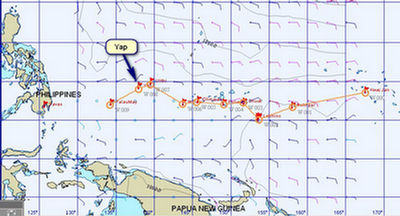
Our Trek Across Micronesia, Highlighting Yap
Yap is an Island/Atoll/State in the NW part of the Federated States of Micronesia (FSM). It is located at 09-30.87 N / 138-07.35 E, 450 Miles SW of Guam.
We found Yap to be an interesting contrast to the other populated centers in the FSM (Chuuk/Truk and Pohnpei). Though Yap is pretty sleepy, we found infrastructure and orderliness that we hadn't expected. Compared to the infrastructure disaster that Chuuk is, Yap really has its act together. There are trash bins and recycling boxes on the street corners--and they are actually USED by the local people. There is hardly any trash lying around.

Road Signs to Help Tourists
A huge number of miles of roads are paved and in good condition, and even the remote dirt roads are maintained. The villages--both ones that the tourists visit on their "culture tour" and the more remote ones--are neat and orderly. People work hard to keep their own grounds clean, and the roadside in their villages. While we were out driving around, we saw several "work crews" from a nearby village out picking up trash along the road. These people are in no way similar to what we saw in Chuuk.
We only stayed 8 days in Yap--we kind of got the "horse headed to the barn syndrome", and pushed on to Palau pretty quickly. But we did get to see a lot of Yap, thanks mainly to Marie and Glen from Backbeat.
Of course, after check-in, my first priority was groceries and Dave's first priority was seeing the World War II stuff. Diving ended up a distant 3rd--the reports on diving Yap were so-so and we knew we were soon moving on to Palau with GREAT diving. We took care of groceries on the first day there, then set out to see as much of Yap as possible.
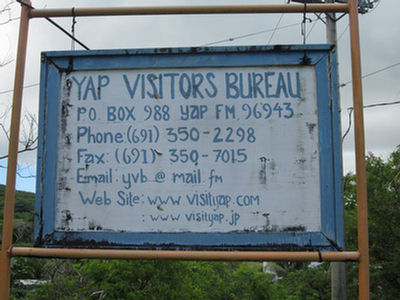
Yap Visitor's Bureau (Struggling for Funding)
Philip and Leslie on Carina (cruising friends that had stayed 2 months in Yap) had told Dave to be sure to look up Tom at the Yap Visitor's Bureau (YVB), and this turned out to be a great tip. Tom is a native Yapese who has gotten as bitten by the World War II bug as Dave is. Tom has been one of primary members of the Yap end of the team for MissingAirCrew.com.
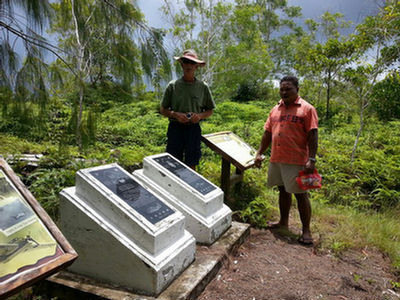
Tom Tamangmow from YVB, Showing Us Their WWII Memorials
Because of Dave's interest in World War II stuff, Tom loaded us up in a 4WD and took us out to show us what Pat from MissingAirCrew.com and Tom and the YVB have been working on--monuments to downed US Airmen in Yap.
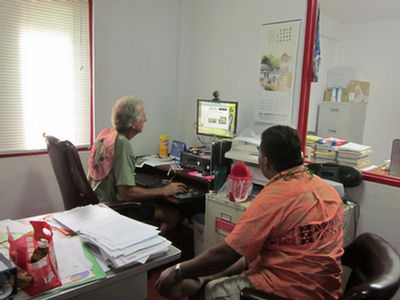
Dave in Tom's Office, Sharing Photos of Micronesian WWII Sites
Pat Ranfranz, back in the U.S., does the research as to planes that went down while bombing Yap. Then he sends Tom out to try to find the plane. Pat also tries to visit Yap at least once a year to do some searching on his own. They have found a lot of them, but they are still looking for a few. We got Glen from Backbeat turned on to this, and he's signed up for a personal mission to try to locate the remains of one specific plane that still has not been found.
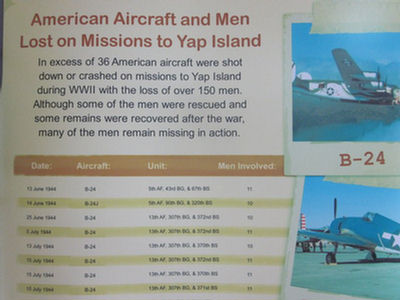
MissingAirCrew.com's List of US Planes Lost Over Yap
The U.S. bombed Yap nearly daily during 1944/45. There were never any plans to invade, but they wanted to keep the Japanese airfield and airplanes unusable. At one point, the Japanese (or Yapese) spelled out on the runway "We Give Up, Please Don't Bomb Any More". (sorry I can't locate this picture, but I think there is a copy of it somewhere on the MissingAircrew.com website).
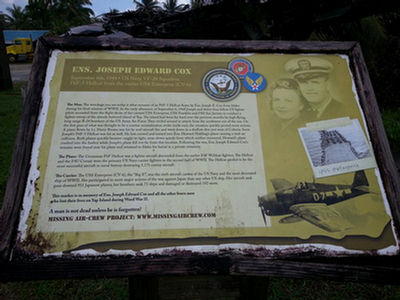
One of the Plaques for Downed U.S. Airmen in Yap
So we got a quickie tour of the close sites by Tom from YVB.
But then Glen and Marie loaded us up in their car and spent two afternoons showing us the rest of the island. We stopped at a bunch of Japanese relics that Glen and Marie had found on their own while out wandering around, plus the best of the "Stone Money Banks". We took waypoints on our GPS for every "Point of Interest" we found, because one of the things that the Yap Visitors Bureau lacks is a good map showing the exact location of all these attractions.
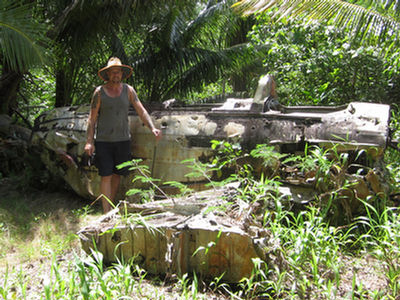
Glen Shows Us a Plane He Found Near the Old Runway
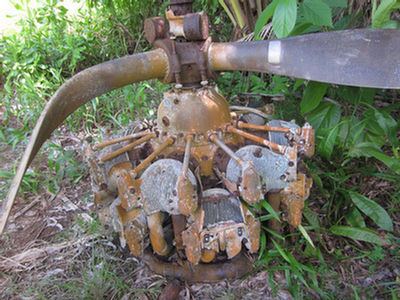
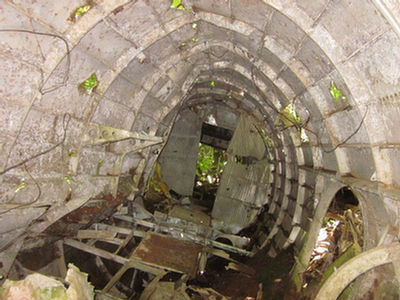
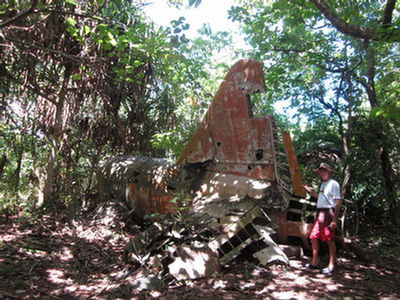
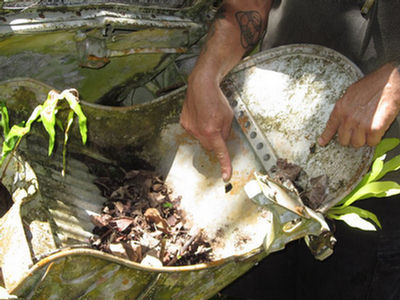
A Bullet Hole in the Cockpit Seat
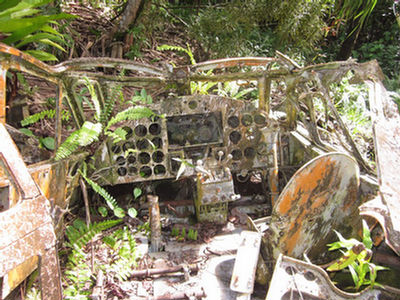
As an example, there is a plaque placed by YVB at the former Japanese lighthouse. Tom had showed us a picture of it, and Dave wanted to go see it. But it's not on any map that we could find in Yap. Fortunately, we got a waypoint from Tom, because we would have never ever found it otherwise.
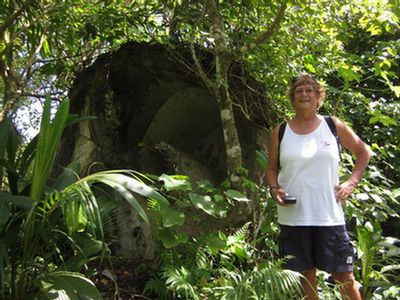
Japanese Light House, On Its Side
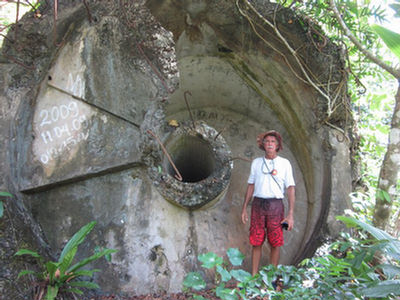
Destroyed by the Japanese, So the US Would Stop Using It For Target Practice
It is way out in the boonies on a dirt road, with no signs marking the way. There was once a road that went all the way to the lighthouse, but now the road peters out, and we ended up parking the car and walking the last mile or so (we had to ask permission to park there from a local, and get directions). And when we got very close (according to the GPS), we still couldn't see the lighthouse and couldn't figure out where it was. It turned out to be a short scramble up a hill, through the jungle. The reason it's not very visible is that the entire structure is now prone in the jungle. The story we heard was that the Japanese pulled the lighthouse down themselves--they were tired of getting bombed every day by U.S. forces.
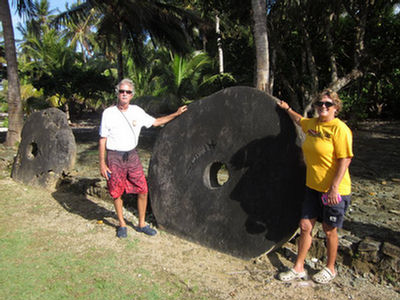
One Typical Example of Yap Stone Money
Stone Money is unique to Yap (and maybe Palau). The Yapese would send canoes to Palau to a special place with some special stone, and quarry these circular stones. They were used as money in Yap (and still are, to a limited extent, in traditional Yapese culture today). We were told that the value of a given stone is not based on the quality of the stonework, nor the type of stone, but more by the story of its voyage from Palau to Yap--how dangerous the trip was, how many men and boats were lost, etc.
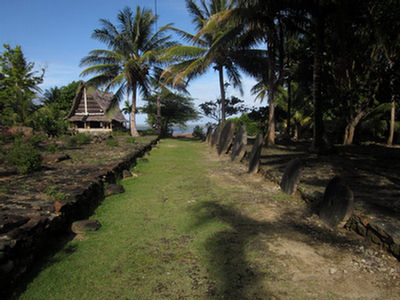
Village "Money Bank" Centered Around the Men's House
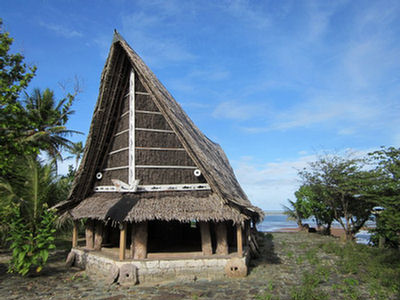
Traditional "Men's House" in Yap
In the mid-1800's an enterprising Irish-American trader, trying to get the Yapese to gather Copra (dried coconut) for him, started bringing stone money from Palau in his trading ships. His colorful exploits were written up in a somewhat fictionalized book called "His Majesty O'Keefe". This was eventually made into a Burt Lancaster movie of the same name (we haven't seen it).
We also stopped by a Clam Farm, where a Belgian guy is trying to grow Giant Clams.
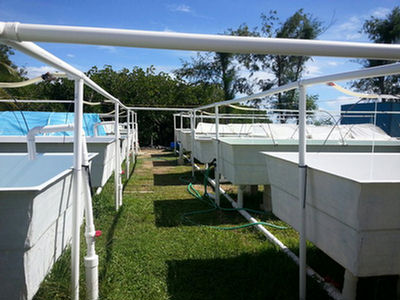
Cultivating the Giant Clam
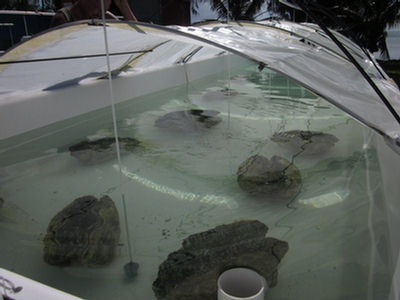
On our way through one village, we saw an old steam-powered roller, rusting in someone's backyard.
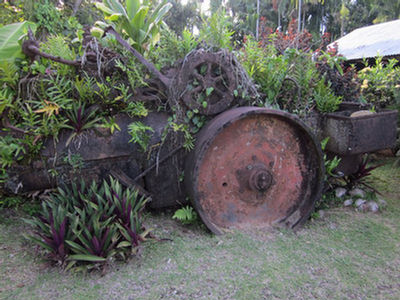
Steam Powered Road Construction Equipment - An Heirloom!
We also got a chance to get an up-close look at a one-man version of a Yap canoe. The entire thing is constructed only of natural materials--no nails, screws, or high tech glue.
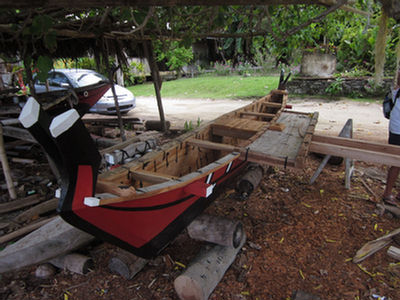
A Yapese One-Man Outrigger Canoe
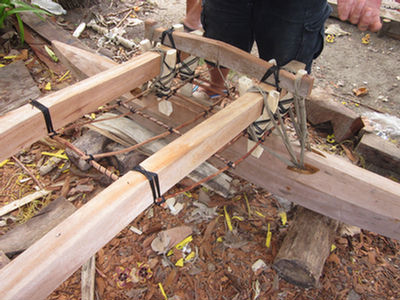
Note the Lashings to Hold Everything Together
We didn't do any diving in Yap. We had heard that the Manta Ray dive was fabulous, but we were past Manta season. And we knew Palau would have better diving.
Having seen most of what Yap has to offer in our short week, we said good bye and good luck to Backbeat, and move on to catch up with our friends who were all in Palau by now.
For more on Yap, see our friends on s/v Lorelei's Blog. They spent a lot more time in Yap than we did. And did some diving there, too.
Yap... where the heck is that? When a cruising friend of ours stopped in Yap a few years ago, I had never heard of it. And still couldn't find it on the map, until we started planning our cruising for this year.

Yap is an Island/Atoll/State in the NW part of the Federated States of Micronesia (FSM). It is located at 09-30.87 N / 138-07.35 E, 450 Miles SW of Guam.
We found Yap to be an interesting contrast to the other populated centers in the FSM (Chuuk/Truk and Pohnpei). Though Yap is pretty sleepy, we found infrastructure and orderliness that we hadn't expected. Compared to the infrastructure disaster that Chuuk is, Yap really has its act together. There are trash bins and recycling boxes on the street corners--and they are actually USED by the local people. There is hardly any trash lying around.

A huge number of miles of roads are paved and in good condition, and even the remote dirt roads are maintained. The villages--both ones that the tourists visit on their "culture tour" and the more remote ones--are neat and orderly. People work hard to keep their own grounds clean, and the roadside in their villages. While we were out driving around, we saw several "work crews" from a nearby village out picking up trash along the road. These people are in no way similar to what we saw in Chuuk.
We only stayed 8 days in Yap--we kind of got the "horse headed to the barn syndrome", and pushed on to Palau pretty quickly. But we did get to see a lot of Yap, thanks mainly to Marie and Glen from Backbeat.
Of course, after check-in, my first priority was groceries and Dave's first priority was seeing the World War II stuff. Diving ended up a distant 3rd--the reports on diving Yap were so-so and we knew we were soon moving on to Palau with GREAT diving. We took care of groceries on the first day there, then set out to see as much of Yap as possible.

Philip and Leslie on Carina (cruising friends that had stayed 2 months in Yap) had told Dave to be sure to look up Tom at the Yap Visitor's Bureau (YVB), and this turned out to be a great tip. Tom is a native Yapese who has gotten as bitten by the World War II bug as Dave is. Tom has been one of primary members of the Yap end of the team for MissingAirCrew.com.

Because of Dave's interest in World War II stuff, Tom loaded us up in a 4WD and took us out to show us what Pat from MissingAirCrew.com and Tom and the YVB have been working on--monuments to downed US Airmen in Yap.

Pat Ranfranz, back in the U.S., does the research as to planes that went down while bombing Yap. Then he sends Tom out to try to find the plane. Pat also tries to visit Yap at least once a year to do some searching on his own. They have found a lot of them, but they are still looking for a few. We got Glen from Backbeat turned on to this, and he's signed up for a personal mission to try to locate the remains of one specific plane that still has not been found.

The U.S. bombed Yap nearly daily during 1944/45. There were never any plans to invade, but they wanted to keep the Japanese airfield and airplanes unusable. At one point, the Japanese (or Yapese) spelled out on the runway "We Give Up, Please Don't Bomb Any More". (sorry I can't locate this picture, but I think there is a copy of it somewhere on the MissingAircrew.com website).

So we got a quickie tour of the close sites by Tom from YVB.
But then Glen and Marie loaded us up in their car and spent two afternoons showing us the rest of the island. We stopped at a bunch of Japanese relics that Glen and Marie had found on their own while out wandering around, plus the best of the "Stone Money Banks". We took waypoints on our GPS for every "Point of Interest" we found, because one of the things that the Yap Visitors Bureau lacks is a good map showing the exact location of all these attractions.






As an example, there is a plaque placed by YVB at the former Japanese lighthouse. Tom had showed us a picture of it, and Dave wanted to go see it. But it's not on any map that we could find in Yap. Fortunately, we got a waypoint from Tom, because we would have never ever found it otherwise.


It is way out in the boonies on a dirt road, with no signs marking the way. There was once a road that went all the way to the lighthouse, but now the road peters out, and we ended up parking the car and walking the last mile or so (we had to ask permission to park there from a local, and get directions). And when we got very close (according to the GPS), we still couldn't see the lighthouse and couldn't figure out where it was. It turned out to be a short scramble up a hill, through the jungle. The reason it's not very visible is that the entire structure is now prone in the jungle. The story we heard was that the Japanese pulled the lighthouse down themselves--they were tired of getting bombed every day by U.S. forces.

Stone Money is unique to Yap (and maybe Palau). The Yapese would send canoes to Palau to a special place with some special stone, and quarry these circular stones. They were used as money in Yap (and still are, to a limited extent, in traditional Yapese culture today). We were told that the value of a given stone is not based on the quality of the stonework, nor the type of stone, but more by the story of its voyage from Palau to Yap--how dangerous the trip was, how many men and boats were lost, etc.


In the mid-1800's an enterprising Irish-American trader, trying to get the Yapese to gather Copra (dried coconut) for him, started bringing stone money from Palau in his trading ships. His colorful exploits were written up in a somewhat fictionalized book called "His Majesty O'Keefe". This was eventually made into a Burt Lancaster movie of the same name (we haven't seen it).
We also stopped by a Clam Farm, where a Belgian guy is trying to grow Giant Clams.


On our way through one village, we saw an old steam-powered roller, rusting in someone's backyard.

We also got a chance to get an up-close look at a one-man version of a Yap canoe. The entire thing is constructed only of natural materials--no nails, screws, or high tech glue.


We didn't do any diving in Yap. We had heard that the Manta Ray dive was fabulous, but we were past Manta season. And we knew Palau would have better diving.
Having seen most of what Yap has to offer in our short week, we said good bye and good luck to Backbeat, and move on to catch up with our friends who were all in Palau by now.
For more on Yap, see our friends on s/v Lorelei's Blog. They spent a lot more time in Yap than we did. And did some diving there, too.
Subscribe to:
Posts (Atom)